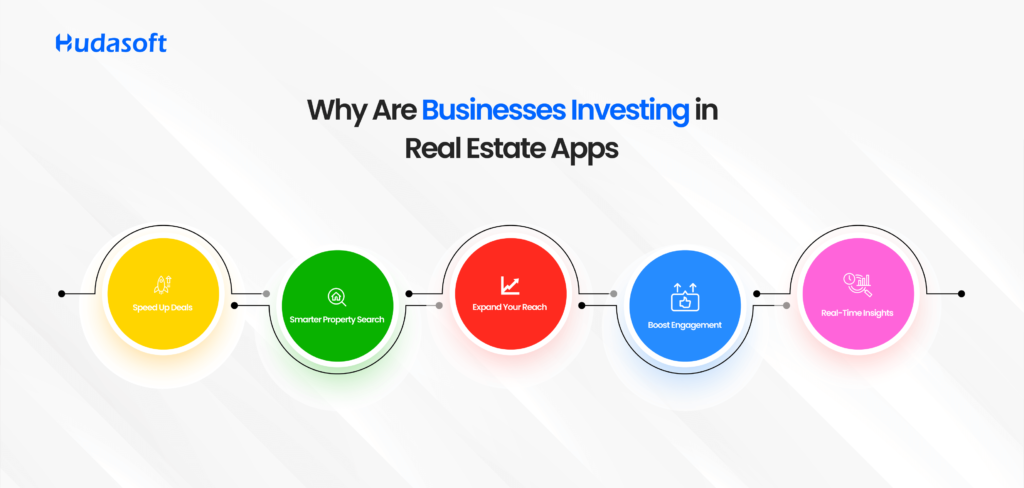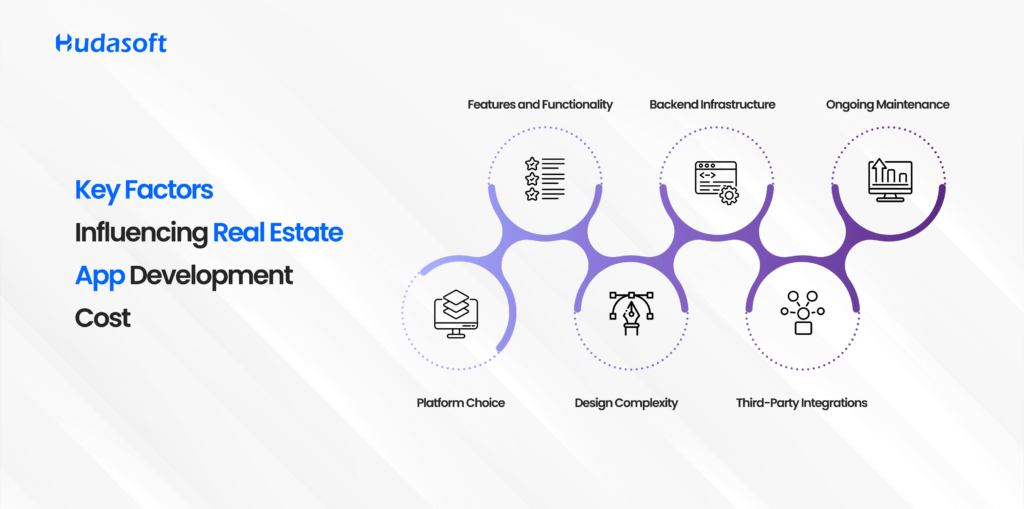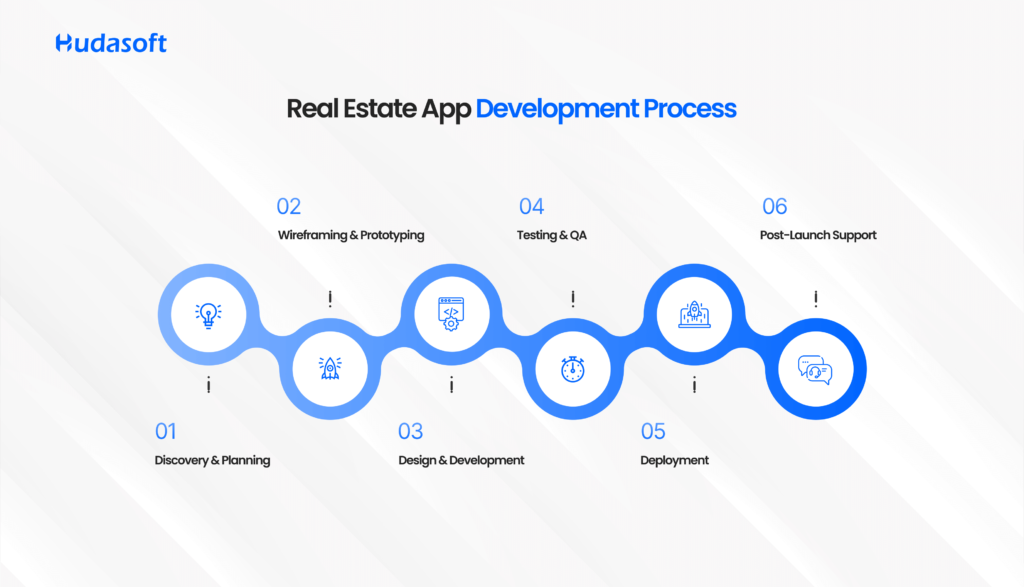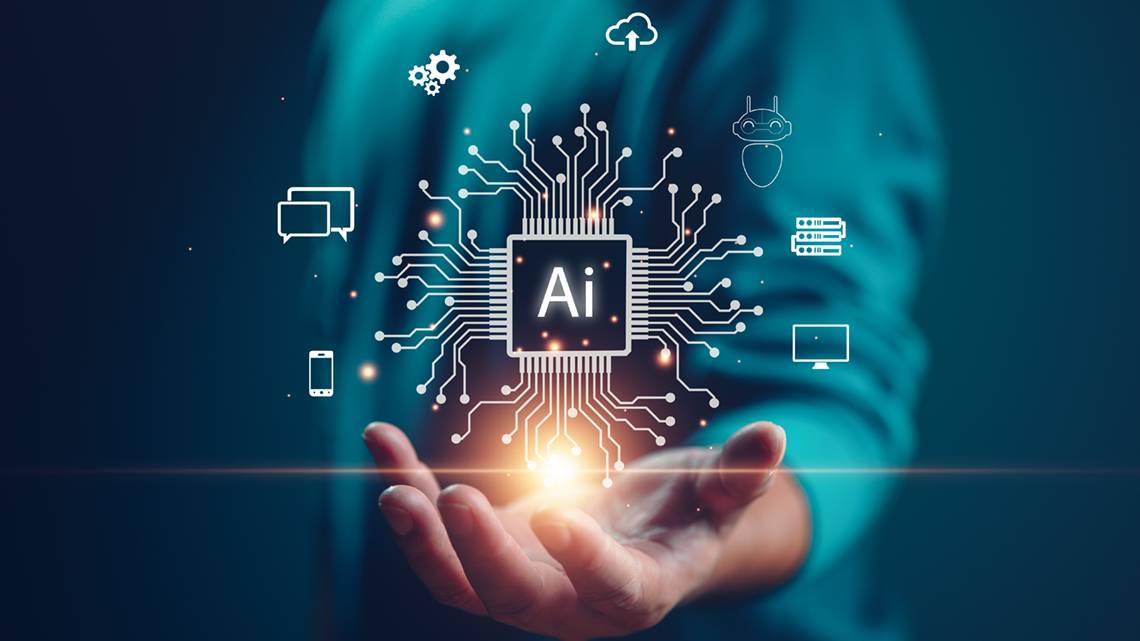In today’s real estate market, a well-built app is more than just a search tool. Everyone wants to build the next Zillow, but most real estate apps don’t even survive the App Store.
Too many businesses rush into development without a clear plan. They end up with something flashy but broken with tools no one uses, and features that don’t fit. Not really made for growth.
According to Deloitte’s 2024 Commercial Real Estate Outlook, nearly 60% of firms are increasing their tech investments, but common mistakes, such as poor user experience (UX), disconnected systems, and limited scalability, often stand in the way.
Real estate tech should work like your best agent: fast, responsive, and always closing.
But getting there requires more than just good code. It takes strategy, research, and a clear roadmap.
In this 10-step guide, we’ll walk you through how to build a real estate app that actually works, not just for users, but for your business. From defining your strategy to launching a high-performing app, here’s how top-performing platforms are doing it right.
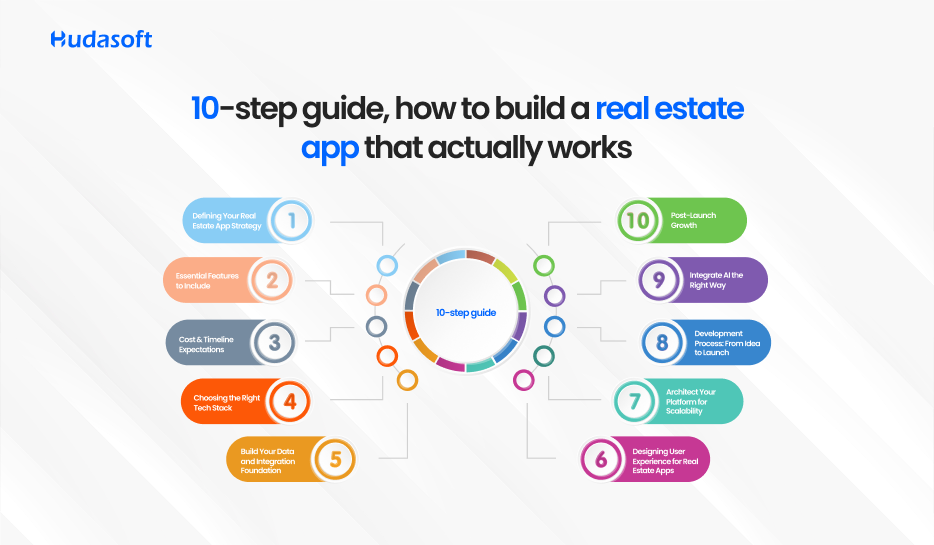
Step 1 — Defining Your Real Estate App Strategy
Before you start looking for real estate app development services, take a step back. You need to know what you’re building and why. Otherwise, you’re just throwing tech at problems you haven’t defined.
Start with the basics.
- What’s not working in your current setup?
- Are agents wasting time juggling too many tools?
- Are clients slipping away because scheduling is clunky or communication is slow?
- Are deals getting delayed because documents live in five different places?
Knowing exactly who you’re building for is equally important. Every real estate app serves a slightly different audience, may it be agents, buyers, renters, or investors, their needs are not the same.
A platform designed for agents needs to focus on speed and deal management. A platform for clients may lean more toward search and user experience. Defining your core audience is key to building an app that works.
Now look outward. You’re not building in a vacuum.
Look at who’s leading. Zillow, Redfin, Trulia, and Compass are platforms with millions of users, huge datasets, and very polished features. But even at their scale, these platforms don’t solve everything for every real estate business. Your job isn’t to copy them. It’s to understand where their models don’t fit your business
Take note of where these platforms fall short:
* They’re built for general audiences, not your exact users.
* They don’t integrate easily with your CRM, franchise tools, or team workflows.
* They often miss features that would help your agents work faster.
This kind of market research isn’t about copying. It’s to spot where their models break down, and build something sharper and more specific to your business needs. That’s where your opportunity is.
Finally, this is where you decide what kind of real estate app you need: a focused solution to support internal operations and agent workflows, or a broader marketplace platform for client-facing engagement.
When you take the time to align your real estate app development strategy with your business goals, target users, and market insights, you’re in a much stronger position to build an app that actually delivers value, not just another product that adds to the noise.
Step 2 — Essential Features to Include
Once your real estate app development strategy is clear, it’s time to plan the features. The right features will make your app something people rely on every single day. A little extra thought here saves a lot of effort later.
Your priorities will depend on your business model and your users. But in most cases, these are the essential features that may be for your MVP, i.e., your starter features.
Buyer & Renter App Features
For buyers and renters, the experience needs to be fast and smooth so that they are kept engaged on your platform and don’t consider switching. Your operations should be streamlined, with no major gaps, helping them move from search to decision, with less friction.
• Property search with smart filters
Helps users narrow listings by location, price, amenities, and personal preferences, so they can find what matters most to them specifically, faster.
• Geolocation-based discovery
Lets users browse listings nearby or dive into neighborhoods they care about. This is perfect for clients who want to explore locally.
• Virtual tours and high-res galleries
Gives clients a real sense of the space without multiple in-person visits. This lets them make a quicker decision that they also have confidence in.
• Push notifications for new listings
Keeps users engaged with instant alerts, so they never miss a property that fits their wishlist.
• Favorites and comparison tools
Lets users easily save, compare, and revisit properties, letting them shortlist their options as they move through the buying process.
• In-app messaging with agents
Creates an instant line of communication. Helps buyers get questions answered and viewings scheduled without jumping between apps.
Agent & Seller Features
For agents and sellers, your real estate application should make it easier to manage listings, leads, and daily tasks, instead of posing a burden to manage their operations on the app as well as manually.
• Property management dashboard
Brings all listings into one place and makes it faster to update property details, pricing, and availability.
• Lead capture and CRM integration
Automatically collects leads and syncs with your CRM, helping agents respond faster and avoid missed opportunities.
• Scheduling for open houses & showings
Keeps calendars in sync so agents can easily manage appointments and keep clients in the loop. This bridges the communication gap that managing it manually creates.
• Real-time analytics & reports
Gives agents clear insights into what’s working — from listing performance to client engagement — so they can adjust their efforts where it counts.
Advanced Features
For businesses looking to build a stronger, more engaging real estate app, these advanced features add serious value.
• AI-powered recommendations
Learns from user behavior to surface better property suggestions. Helping clients discover homes they might otherwise miss.
• Chatbots for lead qualification
Handles initial lead conversations automatically. This saves a lot of agents’ time and helps them focus on qualified prospects.
• Mortgage & affordability calculators
Gives buyers a clear view of their options. They move from browsing to choosing swiftly.
• AR-based property visualization
Lets users explore properties in 3D, offering an immersive experience that keeps them engaged and satisfied.
Step 3 — Cost & Timeline Expectations
Before development starts, you need clarity on where your investment is going. You’re not paying for screens and features. You’re building the system that controls how leads flow, how data moves between systems, how agents work, and how your clients experience your business day to day.
That’s why your budget depends on how much you’re trying to centralize. The more disconnected processes you’re bringing into one place, the more it takes to get the foundation right.
For most real estate businesses, a lean MVP that covers core workflows starts around $50K–$ 80 K. A full real estate platform with CRM, AI, advanced search, and reporting usually ranges between $120K–$ 250 K+.
As for timelines, a basic MVP can usually launch in 4–6 months. A full build — especially if you’re replacing legacy systems — often takes closer to 8–12 months.
A few things will shape both the cost and how fast you get there:
• How much of your business are you trying to centralize?
• How many systems need to talk to each other?
• How much needs to be built from scratch vs. existing tools?
• How available is your team to give feedback and make decisions during the build?
One mistake to avoid: trying to budget before you really know what your platform needs to do. That’s when you see projects rebuilt — what looked affordable upfront can’t support operations six months later.
Your focus should be long-term stability, not short-term savings. The right system pays itself back through cleaner workflows, fewer errors, and faster deals, and helps you avoid the much bigger expense of rebuilding to fix your inconsistencies.
Step 4 — Choosing the Right Tech Stack
Once your features and scope are clear, the next decision is your tech stack — what your real estate app is actually built on. This matters more than most people think. The right stack gives you speed, flexibility, and room to grow. The wrong one can slow everything down six months in.
First, there’s the question of platform:
• Native apps (built separately for iOS and Android) give you the best performance, but also the highest development and maintenance effort.
• Hybrid or cross-platform frameworks like Flutter or React Native can get you to market faster, with one codebase across both platforms. For most real estate apps, this is often the more practical route.
Next is your backend. A real estate app moves a lot of data like properties, leads, users, content, and needs to handle growth without lag. A cloud-based, scalable architecture is the key here.
AWS, Firebase, or Azure are common choices; secure, reliable, and built to scale. Choose a stack that lets your app grow with your business, not hold it back.
Your platform will also need to talk to other tools — no app works in isolation. Plan for seamless API integrations with:
• MLS databases
• CRM systems
• Payment gateways
• Marketing tools and other internal platforms
Finally, you need to think about compliance. Your real estate app will be handling personal data, client info, lead details, other communications. Hence, building in data privacy and meeting GDPR and local regulations from the start is a must.
Choosing the right tech stack lets you build something solid that supports your business now, and gives you room to evolve as your needs grow.
Step 5 — Build Your Data and Integration Foundation
Every successful real estate app rests on one thing most businesses overlook early: the data foundation.
You can have great design, perfect features, but if your data is messy or your systems don’t talk to each other, it all breaks down sooner or later.
Without a strong foundation, even the best real estate app development projects hit walls. Frustrated users, disconnected workflows, and mounting costs trying to patch things together is what you may see if your foundation isn’t strong.
Here’s what your real estate platform needs to get right from day one:
• Verified property data
Your listings need to sync cleanly with trusted sources — MLS feeds, ATTOM, DataTree, Regrid — so every property shows accurate ownership records, pricing, status, and location.
• Seamless CRM integration
Your client records, agent pipelines, and lead flows should stay fully updated in real time — no more chasing missing data between platforms.
• Secure payment processing
Whether handling deposits, transactions, or fees, integrated payment gateways keep money moving safely.
• Automated document handling
Contracts, e-signatures, and compliance workflowsools like DocuSign or HelloSign help you manage the paperwork side, without obstacles.
• KYC and identity verification
Fraud prevention and compliance with growing security rules, automated identity verification keeps your platform protected.
If you don’t map these integrations early, you’ll find yourself constantly patching systems later. Getting the data foundation right upfront sets your real estate app up to scale smoothly as the business grows.
Step 6 — Designing User Experience for Real Estate Apps
Real estate app development fails when it focuses on features instead of actual workflows. Don’t build just another property search tool, instead build a system your business can rely on.
That’s why UX matters. A good real estate app makes complex tasks feel simple. Whether someone is searching for the right property, managing leads, or handling documents on the go.
Here’s what to focus on
• Intuitive search experience
Your app will handle complex searches like price, location, features, financing, and more. The key is making those options easy to use, not overwhelming. If clients can’t find what they want quickly, they’re quick to become uninterested.
• Building trust through design
Design isn’t just about looks. Clean, polished design builds credibility especially when users are making major financial decisions. Every screen in your real estate app should feel professional and reliable.
• Onboarding that drives engagement
First impressions count. A smooth onboarding flow helps users understand the app and start getting value right away which keeps them coming back.
• Speed and responsiveness
Fast load times matter, especially on mobile. If your real estate platform lags when loading listings, images, or reports, users won’t wait around. The app needs to feel quick, no matter how much data is moving behind the scenes.
A real estate app with strong UX becomes something people want to use — not just another tool they have to fight with.
Step 7 — Architect Your Platform for Scalability, Not Just Launch
Too many real estate apps work fine — until they don’t. They’re built to launch fast, but not built to scale. That’s why so many businesses find themselves rebuilding or re-platforming a year or two in.
Real estate app development done right starts with two things:
a scalable architecture, and a smart MVP phase.
You don’t need every feature on day one. What you do need is a Minimum Viable Product (MVP) that locks down your core workflows and gives your team something stable to build on. For most real estate businesses, that looks like this:
• Lead capture and automated CRM routing
• Calendar scheduling for property viewings
• In-app messaging and push notifications
• Contract generation with e-signature integration
• Secure payments and deposit processing
• Basic CRM and MLS data integrations
Launching with this core lets you get live faster, engage early users, and — more importantly — lets real-world feedback guide what comes next.
But while your MVP can start lean, your architecture can’t. The system behind it needs to assume you’re going to scale — more agents, more listings, more clients, more integrations, more data.
That’s why your platform should be cloud-native from day one, with scalable microservices where each piece including, CRM sync, MLS feeds, payments, and messaging can run and scale independently.
A good MVP stabilizes your launch. The right architecture future-proofs your growth so your real estate app runs just as smoothly at 50 users as it will at 5,000.
Step 8 — Development Process: From Idea to Launch
By this stage of real estate app development, your platform is no longer just a list of features — it’s a working system. But it’s not ready for launch until it’s been tested against the real-world conditions your business will run on.
Basic QA or device testing isn’t enough here. You need operational testing that mimics real business usage — where workflows, integrations, and edge cases are all validated under real pressure.
The process should look something like this:
• Discovery and scoping
Upfront, your project team should work with you to map exactly what needs to happen — not just what screens need to be built, but how the entire system should run day-to-day.
• Agile sprints and iterative releases
Rather than waiting six months for a big launch, development should run in agile cycles — shipping small releases regularly so your team can test and give feedback early.
• User testing & QA
This is where real progress is made. Every integration — MLS feeds, CRM syncs, payment gateways, document handling, AI models — needs to be tested under actual usage. Think:
- Real transaction volumes
- Multi-party contract workflows
- Complex scheduling (reschedules, cancellations, agent reassignments)
- Lead flows under both high-volume and low-volume conditions
- Security risks (data breaches, fraud attempts, onboarding vulnerabilities)
• Launching on app stores
Once your platform is stable, it’s time to prep for launch — with proper store approvals, final production QA, and the operational readiness to support your team and users from day one.
The goal here isn’t just to check that every feature works. The goal is to confirm that the entire real estate platform behaves the way your business needs it to — under real-world conditions — so when you launch, everything flows.
Step 9 — Integrate AI the Right Way
Most real estate businesses aren’t struggling because they don’t have enough listings or filters. They’re struggling because agents spend too much time qualifying cold leads, buyers drop off when pricing feels off, and contracts get delayed by manual errors.
That’s where AI-powered real estate app development creates real business value, by removing friction at key deal stages and freeing up your team to focus where it counts.
Here’s exactly where AI belongs inside your real estate app:
• Lead Scoring
AI models connected to your CRM can automatically score and prioritize incoming leads based on behavior, profile data, and engagement helping agents focus on the right opportunities.
• Property Recommendations
AI-driven recommendation engines surface listings personalized to each user’s search patterns, saved preferences, and activity
• Dynamic Pricing
Pricing algorithms analyze MLS data, neighborhood trends, and past sales giving agents real-time insights on where to price competitively.
• Contract Review
AI document intelligence can scan contracts as they’re generated, flagging missing fields, compliance gaps, or risky clauses before they cause problems.
• Fraud Detection
AI tied into KYC and identity verification helps catch fraud attempts early. This protects both your clients and your business.
• Predictive Analytics
AI can analyze your pipeline and agent activity, helping managers forecast deals, spot bottlenecks, and optimize team performance.
AI in real estate app development isn’t about adding flashy tech. it’s about cutting manual friction, speeding up deals, and giving your team better insight to work smarter.
Step 10 – Post-Launch Growth
A real estate app launch isn’t just flipping a switch. You’re rolling out a full operational system that will change how your agents, managers, and clients work daily. Agents need clear workflows for lead management, scheduling, communication, and contracts, all running inside the platform. Managers must be trained on dashboards, reporting, and compliance tracking from day one. Clients need simple, fully digital onboarding that makes adoption easy.
Behind the scenes, your MLS feeds, CRM syncs, payment gateways, and document flows should be fully live and monitored as real activity picks up. AI models should start learning from early user behavior while running on pre-trained data.
But real estate app development doesn’t stop at launch — that’s when the real growth happens.
As your team and clients use the platform daily, you’ll start collecting valuable data:
• User feedback
Direct input from agents and clients about what’s working and what isn’t.
• Usage patterns
Helps identify which features drive engagement, where drop-offs happen, what workflows feel clunky.
• AI model tuning
Lead scoring gets smarter, pricing adjusts with market shifts, search recommendations improve.
• Back-office insights
Clarifies areas where automation can be improved or added.
Regulations, MLS rules, and compliance standards will evolve too. Your real estate platform should be built for this so updates can roll out in small, steady improvements, without full rebuilds.
Post-launch, growth comes from listening to real users and letting data guide the roadmap. This is how your real estate app keeps getting better, faster, and more valuable to your business.
Final Words
The difference between apps that scale and apps that fail comes down to how they’re built.
Real estate app development is about building a system that integrates your business operations, automates complexity, and creates long-term stability for growth.
Done right, your app becomes your operating system. Simplifying agent workloads, improving client experiences, and driving faster deals at scale.
Frequently Asked Questions
How to develop a real estate app?
Hire a development team to build a custom app with listing, search, and CRM features based on your business goals.
How do I start building a real estate app?
Start by defining your target users, required features, and budget, then consult with a real estate app developer.
How much does it cost to develop a real estate app?
A real estate app can cost between $50,000 and $300,000+ depending on features, platforms, and complexity.
How long does it take to build a real estate app?
Development typically takes 4 to 9 months depending on the app’s scope and feature set.
